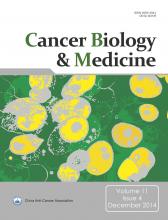Review ArticleReview
Combining targeted therapy and immune checkpoint inhibitors in the treatment of metastatic melanoma
Kim Teresa, Rodabe N. Amaria, Christine Spencer, Alexandre Reuben, Zachary A. Cooper and Jennifer A. Wargo
Cancer Biology & Medicine December 2014, 11 (4) 237-246; DOI: https://doi.org/10.7497/j.issn.2095-3941.2014.04.002
Kim Teresa
1Department of Surgery, Massachusetts General Hospital, Boston, MA 02114, USA
2Harvard Medical School, Boston, MA 02115, USA
Rodabe N. Amaria
3Department of Melanoma Medical Oncology
Christine Spencer
4Department of Genomic Medicine
Alexandre Reuben
5Department of Surgical Oncology, University of Texas M.D. Anderson Cancer Center, Houston, TX 77030, USA
Zachary A. Cooper
4Department of Genomic Medicine
5Department of Surgical Oncology, University of Texas M.D. Anderson Cancer Center, Houston, TX 77030, USA
Jennifer A. Wargo
4Department of Genomic Medicine
5Department of Surgical Oncology, University of Texas M.D. Anderson Cancer Center, Houston, TX 77030, USA

References
- 1.↵
- Siegel R,
- Ma J,
- Zou Z,
- Jemal A.
- 2.↵
- 3.↵
- Beddingfield FC 3rd..
- 4.↵
- 5.↵
- Patel PM,
- Suciu S,
- Mortier L,
- Kruit WH,
- Robert C,
- Schadendorf D, et al.
- 6.↵
- Sasse AD,
- Sasse EC,
- Clark LG,
- Ulloa L,
- Clark OA.
- 7.↵
- Ives NJ,
- Stowe RL,
- Lorigan P,
- Wheatley K.
- 8.↵
- Atkins MB,
- Lotze MT,
- Dutcher JP,
- Fisher RI,
- Weiss G,
- Margolin K, et al.
- 9.↵
- 10.↵
- Schwartzentruber DJ,
- Lawson DH,
- Richards JM,
- Conry RM,
- Miller DM,
- Treisman J, et al.
- 11.↵
- Pardoll DM.
- 12.↵
- Ahmadzadeh M,
- Johnson LA,
- Heemskerk B,
- Wunderlich JR,
- Dudley ME,
- White DE, et al.
- 13.↵
- 14.↵
- Robert C,
- Thomas L,
- Bondarenko I,
- O’Day S.
- 15.↵
- Topalian SL,
- Hodi FS,
- Brahmer JR,
- Gettinger SN,
- Smith DC,
- McDermott DF, et al.
- 16.↵
- Ribas A,
- Hodi FS,
- Kefford R,
- Hamid O,
- Daud A,
- Wolchok JD, et al.
- 17.↵
- Brahmer JR,
- Tykodi SS,
- Chow LQ,
- Hwu WJ,
- Topalian SL,
- Hwu P, et al.
- 18.↵
- Wolchok JD,
- Kluger H,
- Callahan MK,
- Postow MA,
- Rizvi NA,
- Lesokhin AM, et al.
- 19.↵
- Sznol M,
- Kluger HM,
- Callahan MK,
- Postow MA,
- Gordon RA,
- Segal NH, et al.
- 20.↵
- Davies MA,
- Stemke-Hale K,
- Lin E,
- Tellez C,
- Deng W,
- Gopal YN, et al.
- 21.↵
- Chapman PB,
- Hauschild A,
- Robert C,
- Haanen JB,
- Ascierto P,
- Larkin J, et al.
- 22.↵
- Hauschild A,
- Grob JJ,
- Demidov LV,
- Jouary T,
- Gutzmer R,
- Millward M, et al.
- 23.↵
- Johannessen CM,
- Boehm JS,
- Kim SY,
- Thomas SR,
- Wardwell L,
- Johnson LA, et al.
- 24.↵
- Flaherty KT,
- Infante JR,
- Daud A,
- Gonzalez R,
- Kefford RF,
- Sosman J, et al.
- 25.↵
- Gorantla VC,
- Kirkwood JM.
- 26.↵
- Nazarian R,
- Shi H,
- Wang Q,
- Kong X,
- Koya RC,
- Lee H, et al.
- 27.
- Straussman R,
- Morikawa T,
- Shee K,
- Barzily-Rokni M,
- Qian ZR,
- Du J, et al.
- 28.
- Montagut C,
- Sharma SV,
- Shioda T,
- McDermott U,
- Ulman M,
- Ulkus LE, et al.
- 29.
- Emery CM,
- Vijayendran KG,
- Zipser MC,
- Sawyer AM,
- Niu L,
- Kim JJ, et al.
- 30.
- Whittaker SR,
- Theurillat JP,
- Van Allen E,
- Wagle N,
- Hsiao J,
- Cowley GS, et al.
- 31.
- 32.↵
- Poulikakos PI,
- Persaud Y,
- Janakiraman M,
- Kong X,
- Ng C,
- Moriceau G, et al.
- 33.↵
- Sumimoto H,
- Imabayashi F,
- Iwata T,
- Kawakami Y.
- 34.↵
- Boni A,
- Cogdill AP,
- Dang P,
- Udayakumar D,
- Njauw CN,
- Sloss CM, et al.
- 35.↵
- Vella LJ,
- Pasam A,
- Dimopoulos N,
- Andrews M,
- Knights A,
- Puaux AL, et al.
- 36.↵
- Callahan MK,
- Masters G,
- Pratilas CA,
- Ariyan C,
- Katz J,
- Kitano S, et al.
- 37.↵
- Cooper ZA,
- Frederick DT,
- Juneja VR,
- Sullivan RJ,
- Lawrence DP,
- Piris A, et al.
- 38.↵
- Frederick DT,
- Piris A,
- Cogdill AP,
- Cooper ZA,
- Lezcano C,
- Ferrone CR, et al.
- 39.↵
- Wilmott JS,
- Long GV,
- Howle JR,
- Haydu LE,
- Sharma RN,
- Thompson JF, et al.
- 40.↵
- Khalili JS,
- Liu S,
- Rodríguez-Cruz TG,
- Whittington M,
- Wardell S,
- Liu C, et al.
- 41.↵
- Liu C,
- Peng W,
- Xu C,
- Lou Y,
- Zhang M,
- Wargo JA, et al.
- 42.↵
- Spranger S,
- Spaapen RM,
- Zha Y,
- Williams J,
- Meng Y,
- Ha TT, et al.
- 43.↵
- Frederick DT,
- Ahmed Z,
- Cooper ZA,
- Lizee G,
- Hwu P,
- Ferrone CR, et al.
- 44.↵
- Jiang X,
- Zhou J,
- Giobbie-Hurder A,
- Wargo J,
- Hodi FS.
- 45.↵
- Koya RC,
- Mok S,
- Otte N,
- Blacketor KJ,
- Comin-Anduix B,
- Tumeh PC, et al.
- 46.↵
- Knight DA,
- Ngiow SF,
- Li M,
- Parmenter T,
- Mok S,
- Cass A, et al.
- 47.↵
- Cooper ZA,
- Juneja VR,
- Sage PT,
- Frederick DT,
- Piris A,
- Mitra D, et al.
- 48.↵
- Hooijkaas A,
- Gadiot J,
- Morrow M,
- Stewart R,
- Schumacher T,
- Blank CU.
- 49.↵
- Ribas A,
- Hodi FS,
- Callahan M,
- Konto C,
- Wolchok J.
- 50.↵
- Puzanov I,
- Callahan MK,
- Linette GP,
- Patel SP,
- Luke JJ,
- Sosman JA, et al.
- 51.↵
- Radvanyi LG,
- Bernatchez C,
- Zhang M,
- Fox PS,
- Miller P,
- Chacon J, et al.
- 52.↵
- Falchook GS,
- Long GV,
- Kurzrock R,
- Kim KB,
- Arkenau TH,
- Brown MP, et al.
- 53.↵
- Postow MA,
- Callahan MK,
- Barker CA,
- Yamada Y,
- Yuan J,
- Kitano S, et al.
- 54.↵
- Sullivan RJ,
- Lawrence DP,
- Wargo JA,
- Oh KS,
- Gonzalez RG,
- Piris A.
In this issue
Combining targeted therapy and immune checkpoint inhibitors in the treatment of metastatic melanoma
Kim Teresa, Rodabe N. Amaria, Christine Spencer, Alexandre Reuben, Zachary A. Cooper, Jennifer A. Wargo
Cancer Biology & Medicine Dec 2014, 11 (4) 237-246; DOI: 10.7497/j.issn.2095-3941.2014.04.002
Jump to section
Related Articles
- No related articles found.
Cited By...
- No citing articles found.










